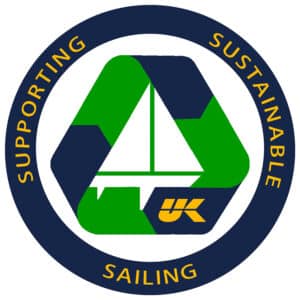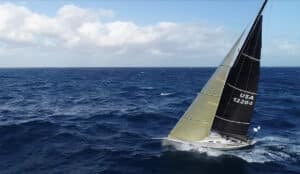An Arcona 435 with a partial taffeta layer up the leech of the main and just on the lower leech and foot of the jib. Peter Gustafsson photo/blur.se
Hallberg Rassy 53 with X-Drive Endure sails where one full side of the sail covered with taffeta and the second side has a partial layer of taffeta on the foot and leech of both the main and genoa.
To help protect X-Drive sails and extend their peak performance lives, UK Sailmakers has a broad range of protective taffeta options. Taffeta protects the sail from abrasion, cracking, creasing and to some extent UV damage. Only UK Sailmakers offers each sailor the option to solve the durability equation with as little or as much extra taffeta to protect their sail. We offer the option of taffeta on one or both sides, or a strip of taffeta up the leech, or just part way up the leech. This article will explain the pros and cons of each option.
While taffeta doesn’t add any strength, it does make sails last longer. The extra durability adds weight and cost. With durability the most important concern for cruising sailors, all of our cruising X-Drive sails come with one side of the sail completely covered with taffeta. For more durability yet, we can add taffeta to the whole second side of the sail or just to the areas of the sail that are more susceptible to damage.
X-Drive Carbon sails with partial taffeta on the main and lower third of the jib leech.
Racing customers also have the choice of adding durability with taffeta, but racers are keenly aware that lighter sails perform better. Therefore, for those who want extra durability without too much extra weight, we have the option of only adding taffeta just where damage is most likely to occur, which is the leech. The leech snaps back and forth when the sail luffs and when it flogs as the sail is raised and lowered. Mainsails can abrade against the backstay. The leeches of overlapping genoas get dragged across the shrouds and the mast every time the boat tacks. Many doublehanded racers and club racers trade the extra durability for the extra weight.
UK Sailmakers will work with you to determine the right amount of taffeta to add to your sails. That decision will be based on your boat, the kinds of sailing you do, and your budget. The pictures in this article show how taffeta can be added in increments from just the lower leech, to the full length of the leech, to the whole second side of the sail.
The L30 One-Design (fleet racing shot), is one of the boats being considered for the mixed offshore doublehanded Olympic sailing event in 2024. The class supplies the boats and sails for major one-design events leading up to the Olympics. Since the boats will be chartered, they and their gear have to be bullet-proof; for that reason, the class chose X-Drive double-sided taffeta sails for the greatest durability.
In summary, to solve the durability equation for your boat, remember that more taffeta creates more durability, but adds more weight and expense.
This photo shows an X-Drive genoa on a Santa Cruz 50. Both sides of the sail covered with Dimension Polyant’s Liteskin. Lightskin is a thin, lightweight sheet of random, non-woven, polyester filaments that is half the weight of taffeta, is a non-woven fine-fiber protective layer that is an ideal upgrade for the racer looking for both durability and light weight sails.




